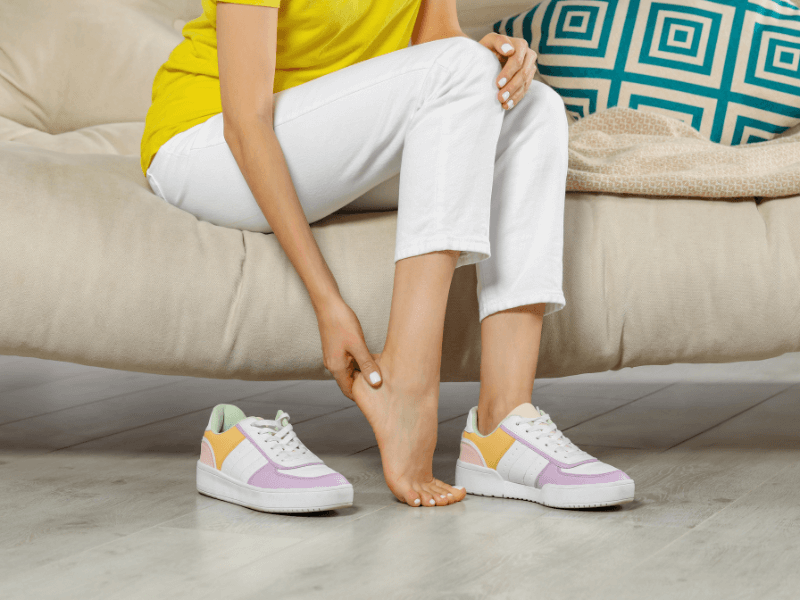Blisters are a common yet painful foot problem that can significantly impact your mobility and comfort. While they often heal on their own, improper care can lead to complications such as infections or foot ulcers, particularly for those with diabetes. Understanding how foot blisters form, how to treat them effectively, and the best ways to prevent them is essential for maintaining healthy feet.
What is a blister?
Essentially, it’s a bubble-like pocket of fluid on the skin. Developing a blister on your foot is normally a sign that your socks, tights or shoes are chafing your skin when you move, leading to excessive friction. Clear fluid is secreted between the damaged upper layer of skin and the lower layers to form a protective ‘cushion’. As the blister heals, the body absorbs the fluid.
What Causes Foot Blisters?
Blisters occur when friction, pressure, or irritation causes the upper layer of the skin to separate from the lower layers, trapping fluid in between. Common causes include:
- Ill-fitting footwear: Shoes that are too tight or too loose can rub against your skin, creating friction. Any shoe that doesn’t fit properly can cause blisters.
- Moisture and heat: Sweaty feet soften the skin, making it more susceptible to damage.
- High-impact activities: Running, hiking, and other prolonged weight-bearing activities increase the risk.
- Underlying health conditions: Conditions like diabetes or circulatory issues can make blisters more prone to infection.
How to Treat a Foot Blister
If a blister develops, proper care can prevent infection and speed up healing:
- Clean the area: Wash your hands and the affected foot with mild soap and water.
- Avoid popping the blister: The fluid-filled sac acts as a natural barrier against infection.
- Use a hydrocolloid dressing: These dressings promote healing and provide cushioning.
- Keep it covered: If necessary, use a sterile bandage to protect the blister.
- Apply antiseptic if it bursts: If the blister pops on its own, clean it with antiseptic and re-cover it.
Signs of Infection – When to See a Podiatrist
Most blisters heal within a few days, but medical attention is needed if you notice:
- Pus or yellow drainage – a sign of bacterial infection.
- Redness, warmth, or swelling around the blister.
- Pain that worsens over time instead of improving.
- Diabetes-related foot blisters that do not heal properly.
Preventing Foot Blisters
Prevention is key when it comes to foot blisters. Follow these steps to keep your feet protected:
- Wear properly fitted shoes: Ensure your shoes have adequate support, cushioning, and toe room.
- Break in new footwear: Wear them at home for short periods before prolonged use.
- Choose moisture-wicking socks: Synthetic or wool-blend socks help reduce sweat buildup. The College of Podiatry suggests wearing socks inside out to stop the seams chafing your feet.
- Apply anti-chafing products: Use petroleum jelly, blister prevention sticks, or anti-chafing creams.
- Keep feet dry: If prone to excessive sweating, use foot powder or moisture-wicking insoles.
- Adjust shoe lacing techniques: Prevent excessive foot movement within the shoe to reduce friction.
- Avoid wearing damp socks and shoes: Change socks regularly, especially during exercise.
FAQs About Foot Blisters
Q: Should I pop a blister on my foot?
A: No, popping a blister increases the risk of infection. Allow it to heal naturally unless advised otherwise by a podiatrist.
Q: How long do foot blisters take to heal?
A: Most minor blisters heal within 3-7 days, while larger or infected blisters may take longer.
Q: Can I continue running or exercising with a blister?
A: It depends on the severity. Small blisters can be protected with dressings, but larger blisters may require rest to prevent worsening.
Q: What should I do if my blister keeps coming back?
A: Recurrent blisters may indicate poorly fitted shoes, excessive sweating, or an underlying foot condition. A podiatrist can assess and recommend appropriate treatments.
Expert Foot Care for Blisters in London
Blisters may seem like a minor issue, but when left untreated, they can lead to serious complications. At Feet By Pody, our experienced London podiatrists offer expert foot care, including tailored blister prevention strategies and diabetic foot assessments.
For professional treatment for blistered feet, please call Feet By Pody today on 0207 099 6657 or book an appointment online.

